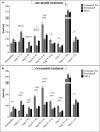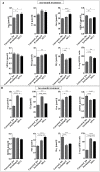Functional and Biochemical Endothelial Profiling In Vivo in a Murine Model of Endothelial Dysfunction; Comparison of Effects of 1-Methylnicotinamide and Angiotensin-converting Enzyme Inhibitor
- PMID: 28443021
- PMCID: PMC5385379
- DOI: 10.3389/fphar.2017.00183
Functional and Biochemical Endothelial Profiling In Vivo in a Murine Model of Endothelial Dysfunction; Comparison of Effects of 1-Methylnicotinamide and Angiotensin-converting Enzyme Inhibitor
Abstract
Although it is known that 1-methylnicotinamide (MNA) displays vasoprotective activity in mice, as yet the effect of MNA on endothelial function has not been demonstrated in vivo. Here, using magnetic resonance imaging (MRI) we profile the effects of MNA on endothelial phenotype in mice with atherosclerosis (ApoE/LDLR-/-) in vivo, in comparison to angiotensin (Ang) -converting enzyme (ACE) inhibitor (perindopril), with known vasoprotective activity. On a biochemical level, we analyzed whether MNA- or perindopril-induced improvement in endothelial function results in changes in ACE/Ang II-ACE2/Ang-(1-7) balance, and L-arginine/asymmetric dimethylarginine (ADMA) ratio. Endothelial function and permeability were evaluated in the brachiocephalic artery (BCA) in 4-month-old ApoE/LDLR-/- mice that were non-treated or treated for 1 month or 2 months with either MNA (100 mg/kg/day) or perindopril (10 mg/kg/day). The 3D IntraGate®FLASH sequence was used for evaluation of BCA volume changes following acetylcholine (Ach) administration, and for relaxation time (T1) mapping around BCA to assess endothelial permeability using an intravascular contrast agent. Activity of ACE/Ang II and ACE2/Ang-(1-7) pathways as well as metabolites of L-arginine/ADMA pathway were measured using liquid chromatography/mass spectrometry-based methods. In non-treated 6-month-old ApoE/LDLR-/- mice, Ach induced a vasoconstriction in BCA that amounted to -7.2%. 2-month treatment with either MNA or perindopril resulted in the reversal of impaired Ach-induced response to vasodilatation (4.5 and 5.5%, respectively) and a decrease in endothelial permeability (by about 60% for MNA-, as well as perindopril-treated mice). Improvement of endothelial function by MNA and perindopril was in both cases associated with the activation of ACE2/Ang-(1-7) and the inhibition of ACE/Ang II axes as evidenced by an approximately twofold increase in Ang-(1-9) and Ang-(1-7) and a proportional decrease in Ang II and its active metabolites. Finally, MNA and perindopril treatment resulted in an increase in L-arginine/ADMA ratio by 107% (MNA) and 140% (perindopril), as compared to non-treated mice. Functional and biochemical endothelial profiling in ApoE/LDLR-/- mice in vivo revealed that 2-month treatment with MNA (100 mg/kg/day) displayed a similar profile of vasoprotective effect as 2-month treatment with perindopril (10 mg/kg/day): i.e., the improvement in endothelial function that was associated with the beneficial changes in ACE/Ang II-ACE2/Ang (1-7) balance and in L-arginine/ADMA ratio in plasma.
Keywords: 1-methylnicotinamide; L-Arg/ADMA ratio; MRI; atherosclerosis; endothelial function; perindopril; plasma angiotensin profile.
Figures




References
-
- Aksoy S., Szumlanski C. L., Weinshilboum R. M. (1994). Human liver nicotinamide N-methyltransferase. cDNA cloning, expression, and biochemical characterization. J. Biol. Chem. 269 14835–14840. - PubMed
-
- Bar A., Skorka T., Jasinski K., Sternak M., Bartel Ż., Tyrankiewicz U., et al. (2016). Retrospectively-gated MRI for in vivo assessment of endothelium-dependent vasodilatation and endothelial permeability in murine models of endothelial dysfunction. NMR Biomed. 29 1088–1097. 10.1002/nbm.3567 - DOI - PubMed
-
- Bartuś M., Łomnicka M., Kostogrys R., Kaźmierczak P., Watała C., Słominska E. M., et al. (2008). 1-methylnicotinamide (MNA) prevents endothelial dysfunction in hypertriglyceridemic and diabetic rats. Pharm. Rep. 60 127–138. - PubMed
LinkOut - more resources
Full Text Sources
Other Literature Sources
Miscellaneous

